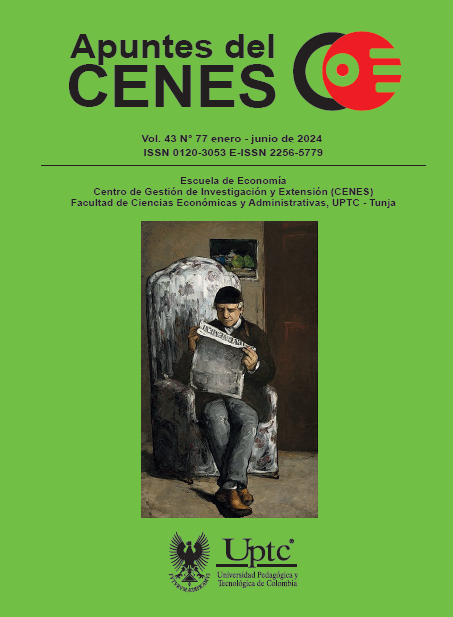El índice Big Mac y su relación con la paridad del poder de compra en el caso colombiano

Resumen
El Big Mac como indicador proxy de la paridad de poder de compra cobra mucha relevancia durante periodos de alta depreciación de la moneda. ¿Se encuentran subvaluadas o sobrevaloradas las monedas con respecto al dólar?, ¿se cumple la paridad del poder de compra (PPC) absoluta y relativa en Colombia? Mediante una estructura de datos de corte longitudinal y la estimación de un modelo de datos de panel, damos respuesta a estas preguntas. Para Colombia se han observado momentos en los que oficialmente se informaba una apreciación del peso frente al dólar, el índice Big Mac detectó una depreciación real. Las estimaciones indican que existe evidencia empírica a favor de la PPC absoluta, es decir, a partir de la ecuación transformada por logaritmos y estimada mediante el método GLS, mientras que no existe evidencia empírica que apoye el cumplimiento de la PPC en términos relativos.
Palabras clave
índice, apreciación, depreciación, cointegración, tasa de cambio, Colombia
Referencias
- Annaert, J. & Ceuster, M. J. K. (1997). The Big Mac: More than a Junk Asset Allocator? International Review of Financial Analysis, 6(3), 179-192. https://ideas.repec.org/a/eee/finana/v6y1997i3p179-192.html
- Balassa, B. (1964). The Purchasing-Power Parity Doctrine: A Reappraisal. Journal of Political Economy, 72(6), 584-96.
- Borgucci, E. (2016). Pensamiento económico de Gustav Cassel, a los 150 años de su nacimiento. Revista de Ciencias Sociales, 22(4).
- Cassel, G. (1921). The World’s Monetary Problems. Constable and Company.
- Click, R. W. (1996). Contrarian MacParity. Economic Letters, 53, 5675.
- Cumby, R. (1996). Forecasting Exchange Rates on the Hamburger Standard: What you See Is What you Get with McParty. NBER Working Paper Series, n.° 5675. National Bureau of Economic Research.
- Harrod, R. (1939). International Economics. Nisbet & Co.
- Lan, Y. (2001). The Long-Run Value of Currencies: A Big Mac Perspective. Economics Discussion/Working Papers. The University of Western Australia, Department of Economics.
- McCloskey, D. N. & Zecher, J. R. (1984). The Success of Purchasing Power Parity: Historical Evidence and its Implications for Macroeconomics. In M. D. Bordo & A. J. Schwartz (eds.), A Retrospective on the Classical Gold Standard, 1880–1913, University of Chicago Press.
- Ong, L. L. (1997). Burgenomics: The Economics of the Big Mac Standard. Journal of International Money and Finance, 16(6), 865-878.
- Ong, L. L. (1998a). Burgernomics and the ASEAN Currency Crisis. Journal of the Australian Society of Security Analysts, (1), 15-16.
- Ong, L. L. (1998b). Big Mac and Wages to Go, Please: Comparing the Purchasing Power of Earnings around the World. Australian Journal of Labor Economics, 2, 53-68.
- Ong, L. L. & Mitchell, J. D. (2000). Professors and Hamburgers: An International Comparison of Real Academic Salaries. Applied Economics, 32, 869-76.
- Pakko, M. R. & Pollard, P.S. (1996). For Here or To Go? Purchasing Power Parity and the Big Mac. Federal Reserve Bank of St. Louis Review, 78.
- Summers, R. & Heston, A. (1991). The Penn World Table (Mark 5): An Expanded Set of International Comparisons, 1950-1988. The Quarterly Journal of Economics, 106 (2), 327-368.
- Taylor, A. M. (2002). A Century of Purchasing Power Parity. The Review of Economics and Statistics, 84(1), 139-150.
- Taylor, A. M. & Taylor, M. P. (2004). The Purchasing Power Parity Debate. Journal of Economic Perspectives, 18(4), 135-158.
- Taylor, M. P. (1995). The Economics of Exchange Rates. Journal of Economic Literature, 33(1), 13-47.
- Taylor, M. P. & Sarno, L. (1998). The Behavior of Real Exchange Rates During the Post-Bretton Woods Period. Journal of International Economics, 46, 281-312.
- Wei, S.-J., & Parsley, D. C. (1995). Purchasing Power Dis-parity During the Floating Rate Period: Exchange Rate Volatility, Trade Barriers, and Other Culprits. Working Paper Series n.° 5032. National Bureau of Economic Research.
